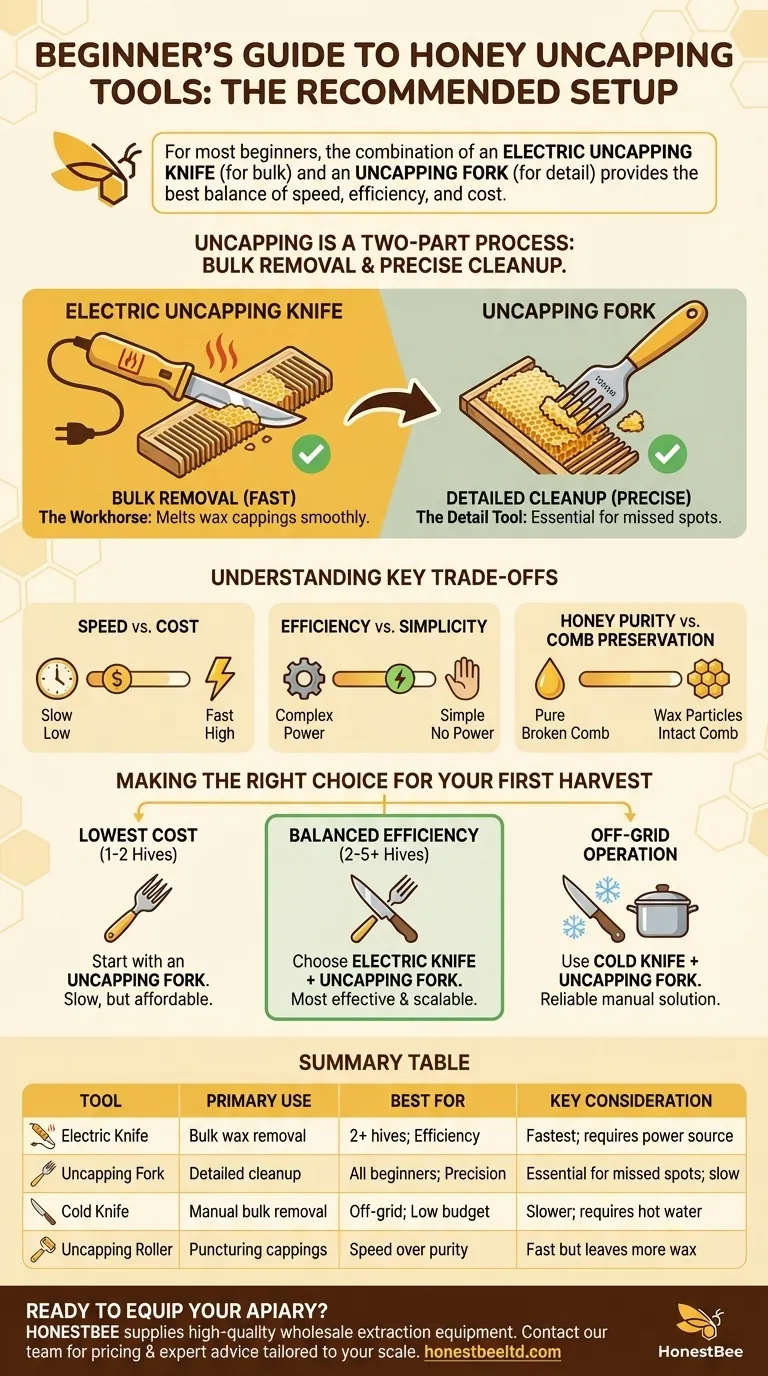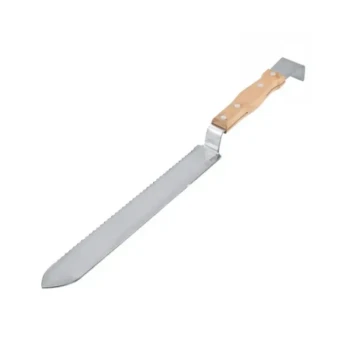For beginner beekeepers, the most effective and recommended starting point for uncapping honey is a combination of two tools: an electric uncapping knife for removing the bulk of the wax cappings and a simple uncapping fork for cleaning up any missed areas. This two-tool setup provides the best balance of speed, efficiency, and cost for someone new to the process.
The core decision isn't about finding a single "best" tool, but about assembling a simple system. Uncapping is a two-part process: fast, bulk wax removal followed by precise, detailed cleanup. Your tool choice should reflect this reality.

Why Uncapping is a Critical Step
Before you can extract honey, you must first remove the protective wax layer, or "cappings," that bees build over each cell of honeycomb. This is the essential process of uncapping.
The goal is to remove this wax layer cleanly and efficiently without damaging the underlying comb structure. Preserving the comb saves the bees immense time and energy on the next honey flow, as they can immediately begin refilling the cells instead of rebuilding them from scratch.
Your Primary Tool Options Explained
While there are many gadgets available, the tools fall into a few distinct categories. Understanding the purpose of each is key to making a smart choice.
The Electric Uncapping Knife (The Workhorse)
An electric uncapping knife has a built-in heating element, similar to an electric carving knife. The heated blade melts through the wax cappings smoothly and quickly.
This is the primary tool for efficiently removing the majority of cappings from a frame. Its speed makes it a favorite for beekeepers with more than one or two hives to process.
The Uncapping Fork or Scratcher (The Detail Tool)
This simple tool looks like a wide fork with many sharp tines. It is used to pierce and lift cappings from areas the knife might have missed, particularly in low spots on the comb.
While you can uncap an entire frame with just a fork, it is a very slow and laborious process. It excels as a secondary, cleanup tool.
The Cold Knife (The Manual Alternative)
A cold knife is simply a long, serrated knife without a heating element. To be effective, beekeepers typically keep two knives in a pot of hot water, alternating between them as one cools down.
This is a low-cost, non-electric alternative to the heated knife, but it is significantly slower and can be more prone to tearing the comb if not kept sharp and hot.
The Uncapping Roller (The Puncturer)
This is a small roller covered in sharp plastic spikes. You simply roll it over the frame to perforate the wax cappings instead of removing them.
While very fast, this method tends to leave more small wax particles in the extracted honey, which requires more filtering later. It punctures the cappings rather than slicing them away cleanly.
Understanding the Key Trade-offs
Your choice comes down to balancing three factors: how much you want to spend, how much time you have, and the quality of the result you want.
Speed vs. Cost
An electric knife is a larger upfront investment but will save you a tremendous amount of time and effort during the harvest.
Manual tools like a cold knife or fork are very inexpensive but will dramatically increase the time it takes to process your frames. For a beginner with only one or two hives, this may be an acceptable trade-off.
Efficiency vs. Simplicity
The combination of an electric knife and a fork is the peak of efficiency for a small-scale beekeeper. It requires a power source and a small learning curve to avoid cutting too deeply into the comb.
A simple fork is foolproof and requires no electricity, but it is the least efficient method for uncapping multiple frames.
Honey Purity vs. Comb Preservation
A sharp knife, used correctly, removes cappings in clean sheets that are easy to separate from the honey. An unskilled cut, however, can damage the underlying comb.
A roller is very gentle on the comb structure but introduces many tiny wax particles into the honey, requiring more straining. A fork offers a good middle ground, preserving the comb well but being very slow.
Making the Right Choice for Your First Harvest
Your ideal starting tools depend entirely on your budget and the number of hives you are managing.
- If your primary focus is the lowest possible cost (1-2 hives): Start with just a simple uncapping fork/scratcher. It will be slow, but it's the most affordable way to learn the process.
- If your primary focus is a balance of efficiency and investment (2-5+ hives): Choose the combination of an electric uncapping knife and an uncapping fork. This is the most common, effective, and scalable setup for a new beekeeper.
- If your primary focus is operating off-grid or without electricity: A cold knife (used with a pot of hot water) paired with an uncapping fork is a reliable and time-tested manual solution.
By understanding that uncapping requires tools for both broad strokes and fine details, you can confidently select the right equipment for a successful first honey harvest.
Summary Table:
| Tool | Primary Use | Best For | Key Consideration |
|---|---|---|---|
| Electric Uncapping Knife | Bulk wax removal | 2+ hives; Efficiency | Fastest method; requires power source |
| Uncapping Fork | Detailed cleanup | All beginners; Precision | Essential for missed spots; slow for bulk work |
| Cold Knife | Manual bulk removal | Off-grid; Low budget | Slower; requires hot water to stay effective |
| Uncapping Roller | Puncturing cappings | Speed over purity | Fast but leaves more wax in honey |
Ready to equip your apiary with the right uncapping tools?
At HONESTBEE, we supply commercial apiaries and beekeeping equipment distributors with high-quality, durable uncapping knives, forks, and other essential extraction equipment through our wholesale-focused operations. Let us help you build an efficient harvesting system that saves you time and preserves your honeycomb.
Contact our team today for wholesale pricing and expert advice tailored to your operation's scale.
Visual Guide

Related Products
- Professional Extra-Wide Uncapping Fork with Bent Tines for Beekeeping
- Professional Z-Shaped Multi-Function Uncapping Knife for Beekeeping
- Honeycomb Uncapping Knife for Apiculture
- Professional Electric Honey Uncapping Knife with Heated Digital Temperature Control for Beekeeping
- Electric Heated Honey Uncapping Knife for Beekeeping
People Also Ask
- What tools can be used to remove the beeswax capping? Choose the Right Tool for Your Harvest
- How does comb depth affect the efficiency of uncapping tools? Match Your Tool for a Faster Harvest
- How do you encourage bees to cap honey? Optimize Hive Conditions for a Perfect Harvest
- What other tools are available for honey uncapping besides knives? Find the Right Tool for Your Apiary's Scale
- How to uncap and extract honey? A Beekeeper's Guide to a Clean, Efficient Harvest



















